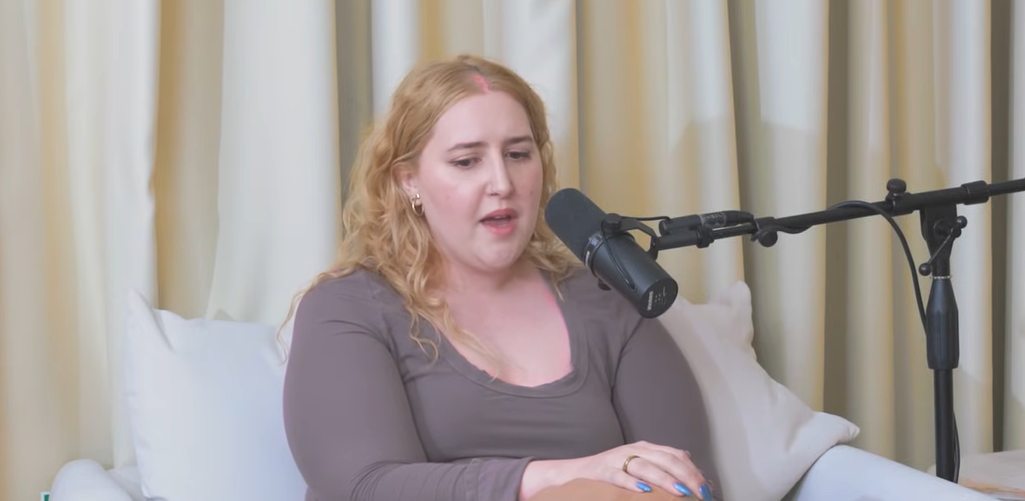On a typical Thursday in London, Honey Ross might seem like just another chic young lady taking in the city while wearing a green maxi skirt and a floral crop top. However, as Honey is well aware, appearances don’t always tell the whole story. Honey, the youngest daughter of writer-producer Jane Goldman and British TV legend Jonathan Ross, has established a space where vulnerability is a tactic and visibility is a statement.
Overcoming the cacophony of tabloid headlines and internet criticism, Honey has emerged as a particularly significant voice in discussions about public identity, body image, and self-worth. Although the industry continues to adhere to antiquated beauty standards, Honey has made it her goal to question those presumptions both intellectually and aesthetically. Although she shares a lot of similarities with characters like Jameela Jamil and Florence Given, her approach has an intimacy that makes her very relatable.
Many creatives turned to social media as a survival tool during the pandemic and its aftermath, and Honey found it to be an incredibly powerful tool for connecting, campaigning, and confronting. In addition to displaying confidence, she is actively redefining what desirability can look like by sharing empowering images on a regular basis, whether they are of her in a bikini or in the sun. These posts, which frequently have bold statements or affirming captions, are surprisingly inexpensive acts of revolution that anyone who wants to be seen on their own terms can access.
| Full Name | Honey Kinny Ross |
|---|---|
| Date of Birth | 1997 (Age: 28 as of 2025) |
| Parents | Jonathan Ross (father), Jane Goldman (mother) |
| Siblings | Harvey Kirby Ross, Betty Kitten Ross |
| Nationality | British |
| Profession | Podcaster, Writer, Activist |
| Education | Privately educated, diagnosed with dyslexia |
| Known For | Body positivity advocacy, “Reel Talk” podcast |
| @honeykinny (57K+ followers) | |
| Podcast | “Reel Talk” with Jonathan Ross |
| Reference | The Sun – Honey Ross Profile |

The development of Honey’s public advocacy was not isolated. She struggled with low self-esteem in her early years, which was made worse by a severe dyslexia diagnosis. For her, school—where many people make their first impressions of themselves—became a place of unease and miscommunication. She subsequently revealed that her family attempted to provide what they thought were remedies—diets intended to enhance her health—in an attempt to deal with those internal issues. But instead of being solutions, those interventions turned into emotional triggers.
Her admission in 2020 that those diets were “toxic” sparked a lot of discussion. It presented an honest picture of what it’s like to grow up with both the benefits and drawbacks of fame. Whether Jonathan and Jane had forced her into body-altering practices was a topic of speculation in the headlines at the time, but Honey swiftly took back the spotlight. She clarified that although her parents had attempted to support her, they ultimately respected her choice to stop, which was a watershed moment for both their relationship and her independence.
That explanation was incredibly clear and profoundly humanizing, especially when it was made in a joint interview with her father. Jonathan acknowledged that they had learned from her and responded with emotional flexibility rather than strict parenting. It depicts a family navigating life in the spotlight, which never goes away. Not only was that honesty relatable to many families, but it was especially helpful for those with children who are neurodivergent or differently abled.
In addition to social media, Honey and her father co-host the podcast “Reel Talk,” which has grown to be a significant emotional component of their relationship. The pair examines current television, film, and the cultural strands that connect them. More than that, though, the show embodies the wonder of intergenerational communication by fusing Honey’s unreserved wisdom with Jonathan’s charm as an experienced professional. Their private conversations are mirrored on this highly adaptable platform, which is now accessible to thousands of people.
By redefining movies as emotional escapes as well as forms of entertainment, Honey has contributed to the development of new conversations about media consumption through “Reel Talk.” She once referred to movies and television as her go-to dissociation technique, a lifeline in trying times. Her reviews become more than just criticisms because many people in a post-lockdown society share that sentiment.
Honey’s heightened awareness of body diversity is further demonstrated by her relationship with her sister Betty, who suffers from chronic illnesses like POTS and fibromyalgia. She often mentions that there is no one-size-fits-all approach to health, which has significantly enhanced public awareness of invisible diseases. Although her activism is frequently centered on appearance, it speaks to broader societal demands for representation, empathy, and dignity.
Fans were recently reminded of the timeless value of genuine connection by images of Honey strolling with her father wearing vintage attire, with Jonathan sporting a tiger print shirt and her dressed in earthy, carefree elegance. These unscripted moments, which are filled with pure joy, depart from the rigidity of staged celebrity photos. They have a lifelike, realistic, and textured feel, almost like stills from a movie that was made by someone who appreciates flaws.
It’s obvious that Honey Ross will keep changing people’s expectations in the years to come. She has already changed the way we think about famous kids—not as mirror images of their parents, but as independent thinkers, artists, and provocateurs. Her podcast, interviews, and social media have all proven to be very effective in changing societal norms regarding personal agency and body image.
Honey is creating a model that is both brave and compassionate by using emotional intelligence and strategic transparency. Her message is unquestionably consistent whether she is speaking on podcasts, posing at the beach, or going braless in see-through mesh: You deserve to take up space. Furthermore, that message is not only audacious but also incredibly trustworthy in a time when filters and façades still rule the day.


